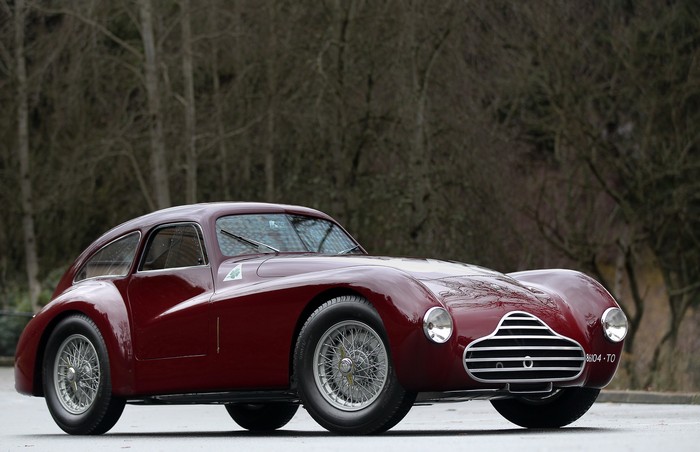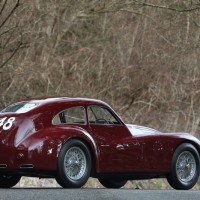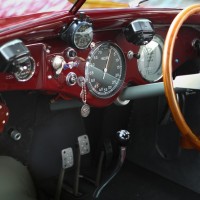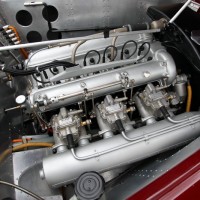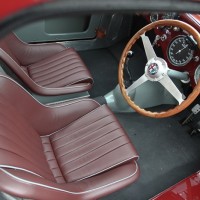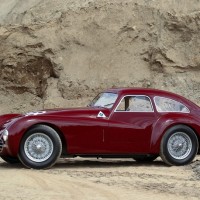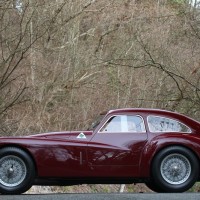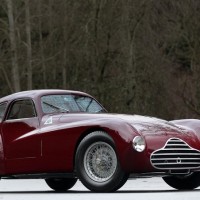Built in the Alfa Corse workshops between 1946 and 1948, this 6C 2500 Competizione, chassis number 920002, was originally sold to Franco Rol of Torino, Italy. An Italian aristocrat turned successful chemical manufacturer, Rol was an avid sportsman who successfully raced a variety of automobiles during the late 1940s and early 1950s.
On May 2, 1948, 920002 made its competition debut at Italy’s most famous road race, the grueling Mille Miglia. But the new Alfa Romeo’s first appearance at the Mille Miglia proved to be a disappointment, as the car failed to finish its maiden race. It was next entered in the Coppa delle Dolomiti to an impressive 5th overall, 1st in class result. 920002 began the 1949 season on March 19 at the Targa Florio in Sicily. Rol maintained a commanding lead until a broken fuel line took them to a 2nd-place finish. On April 24, 1949, the Alfa returned to Brescia for the Mille Miglia. Against 300 other cars, Rol and Richiero drove to a class win and 3rd overall behind two Ferraris.
The 1950 season kicked off at the Targa Florio on April 2, and 920002 managed a 2nd in class and 6th overall — a strong result for a car in its third season of active racing. Despite serious opposition from a host of new sports cars, the 6C 2500 Competizione remained competitive well into the 1951 season. In July 1951, Rol sold 920002 to Denis Spagnol and shipped it to Switzerland through Lausanne. During his ownership, Spagnol entered the Alfa Romeo in local sporting events and modified the grille by fitting wide vertical bars and auxiliary driving lights. In October 1953, Jean Charles Munger of Thônex, Switzerland, purchased the Alfa and continued to race it. During this time it was treated to a general refurbishment and the front grille was further modified in the style of the classic Ferrari egg crate.
In November 1954, the 6C was sold to Swiss car collector Michel Dovaz, the proprietor of a successful printing business. For nearly three decades, 920002 remained hidden away in Dovaz’s chateau outside of Paris. Over the years, the Alfa Romeo was joined by an astonishing number of rare and important cars, including several Bugattis, Ferraris, Rolls-Royces and Bentleys.
In the 1980s, Dovaz’s collection gained fame following the publication of Sleeping Beauties, which depicted the elegant decay of his motorcar collection. In 1984, just as the Dovaz collection was being relocated to a more discreet setting, the 6C 2500 Competizione was pulled from storage and Club Alfa Romeo de France was given the opportunity to prepare the historic car to run the Mille Miglia Retrospective.
In 1995, Belgian Alfa Romeo specialist Raoul San Giorgi bought 920002, marking the first ownership transfer in over 40 years. From there, the 6C 2500 Competizione was sold to Nicholas Springer but eventually returned to Mr. San Giorgi. Since 2005, 920002 has been a part of an exclusive private collection in Washington state. The current owner, who is both a knowledgeable collector and a world-renowned restorer, maintains a deep appreciation for the finest Italian sports cars and has developed a particular affinity for the Alfa Romeo marque. Over the past two decades, he has restored many important sports cars, from pre-war Alfa Romeos to 250 Ferraris, and his exceptional work has been awarded with countless accolades at the leading concours d’elegance. Significantly, he executes all the mechanical work on his cars.
SCM Analysis
Detailing
| Vehicle: | 1948 Alfa Romeo 6C 2500 Competizione |
| Years Produced: | 1948 |
| Number Produced: | Three (Competizione) |
| Original List Price: | N/A |
| Tune Up Cost: | $950 |
| Chassis Number Location: | On bulkhead |
| Engine Number Location: | Intake side of block |
| Club Info: | Registro Internazionale Alfa Romeo 6C 2500 |
| Website: | http://www.6c2500.org |
This car, Lot 114, sold for $4,840,000, including buyer’s premium, at the Gooding & Company Pebble Beach sale on August 18, 2013.
As competition resumed after World War II, Alfa Romeo looked forward to the opportunity to assert its strengths once more in the temporary absence of its German competitors. With the well-developed 6C 2500 model from the late pre- and early-war period once again in production in the newly rebuilt factory, it was time to go racing.
The Alfa factory race cars of this period are much sought-after, as almost none have survived. It is also quite easy to create replicas, using newly built chassis and the mechanicals from the largely unloved Freccia d’Oro factory-bodied two-door.
Our subject car has an uninterrupted history from new — and the benefit of having been cast aside into long-term storage in a very famous collection. Having been in the legendary “Sleeping Beauties” hoard of Michel Dovaz from 1954 until the mid-1990s, there could be no doubt of its authenticity.
It can be argued that a “proper” restoration represents a vehicle at a very specific point in time. I say “proper” because it is possible to combine aspects and components from varying periods in a car’s life in a single restoration. It is common in Italy to see traces of doorways, arches and windows spanning centuries on a single “restored” facade. However, that is rarely desired in a car, as we most often want to see how the car looked at its most important historical moment. To do anything else results in something far worse than a re-creation — a strange historical pastiche.
Bringing the car back
When the seller purchased this Alfa, it had been generally well preserved and attractively restored in most aspects. Nevertheless, it represented a challenge for him, a well-known and highly regarded collector and restorer known for his meticulous nature and almost obsessive concern for details. From the time of its discovery in the Dovaz Collection, the car had first undergone a somewhat casual refurbishment at the hands of the French Alfa Club to prepare it for the 1984 Mille Miglia Storica. Its actual restoration began with its sale in 1995 and ran through four changes of hands between three owners on two continents for the next decade.
Tracing the various changes and adaptations this car endured during its period competition days, post-exhumation refurbishment and restoration became a project in itself. When the car was first brought back into public view in 1984, the well-meaning folks who worked on it had little idea what was correct or original — or even which period of the car’s past they wished to recapture. They simply wanted to get it running and on the road as quickly as they could.
There is no doubt that this car suffered accident damage while racing, and it has worn at least three different grille configurations in the course of its existence. As an example, when purchased by the seller, the shape of the grille was still not right, and it wore incorrect headlights that were larger than the originals.
Fitting the appropriate, smaller-diameter lights meant correcting the profile of the curve of the front fenders to flow correctly to the lamps. In previous stages of the restoration, portions of the bodywork on the front and rear that had been bodged for years were cut away and replaced with panels created to match the originals as seen in the 1949 Mille Miglia.
The seller was able to obtain many of the original pieces that had been removed from the car during restoration, and they form an invaluable look into the life and history of the Alfa.
The doors, hood, rear and inner structure of the Alfa are the original panels that left Portello in 1949. The car had also lost its original engine, which was reunited with the chassis in the final stages of the restoration.
A great story
The quality and correctness of the work was seen in the 2nd in Class award it won at the Pebble Beach Concours d’Elegance in 2005, where it may have only missed out on a 1st in Class prize thanks to a failed brake-light switch. All the original documents and bits and pieces have gone to the new owner — including the key fob from the 1949 Targa Florio.
This is a fabulous example of a car with a story — but in this case, it’s a great one. It demonstrates dramatically how far the sources for research have deepened in the past decade — and how important it is to either do that work or to buy a car from someone who has done it. It pays dividends not only in what we know about a car, but in how it is restored and preserved for the future. Well bought and appropriately sold. ?
(Introductory description courtesy of Gooding & Company.)
